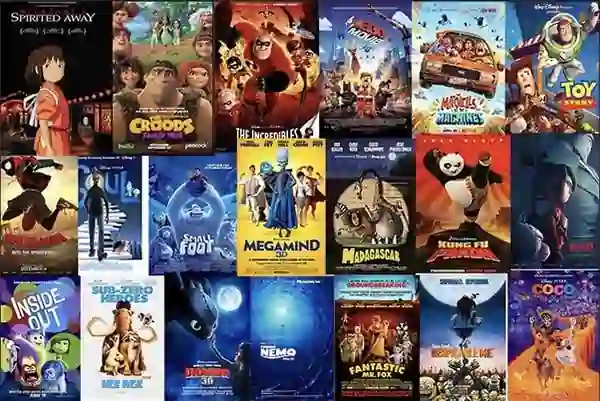Future of Animated Films: An In-Depth Exploration
Introduction
In recent years, the realm of animated films has undergone transformative changes, heralding a new era of creativity, technology, and storytelling. The future of animated films is not just a topic of discussion among industry insiders but a subject of fascination for audiences worldwide. As we delve into this intricate landscape, we aim to shed light on the trends, innovations, and emerging technologies shaping the future of this beloved genre. Our comprehensive analysis will provide insights into how animation studios are adapting to evolving audience preferences, the impact of technological advancements, and the potential trajectories of animated filmmaking.
What Defines the Future of Animated Films?
Technological Innovations in Animation
The future of animated films is intrinsically linked to technological advancements. From groundbreaking software to cutting-edge hardware, technology continues to push the boundaries of what’s possible in animation.
Emergence of AI and Machine Learning
Artificial Intelligence (AI) and Machine Learning (ML) are revolutionizing the animation industry. These technologies are enabling animators to create more realistic and detailed animations with greater efficiency. AI-driven tools can automate labor-intensive tasks, such as in-betweening and coloring, allowing animators to focus on creative aspects.
Virtual Reality (VR) and Augmented Reality (AR) Integration
The integration of VR and AR into animated films offers immersive storytelling experiences. VR allows viewers to step into the animated world, providing a 360-degree perspective, while AR enhances real-world environments with animated elements. These technologies promise to redefine audience engagement and interaction.
Evolving Animation Techniques
The techniques used in animation have evolved significantly, impacting the future of animated films. Traditional hand-drawn animation, while still cherished, is being complemented by advanced techniques such as 3D animation, motion capture, and procedural animation.
3D Animation and Beyond
3D animation continues to dominate the industry, with studios leveraging its capabilities to create visually stunning films. Innovations like real-time rendering and physically-based rendering (PBR) are enhancing the realism and aesthetic appeal of 3D animations.
Motion Capture Technology
Motion capture technology, commonly used in live-action films, is making significant inroads into animation. By capturing the movements of live actors, animators can create more lifelike and expressive characters. This technology is particularly useful for achieving realistic human and animal motions.
Storytelling and Thematic Evolution
The future of animated films is also shaped by evolving storytelling techniques and themes. Modern animated films are exploring complex narratives, diverse genres, and mature themes, appealing to a broader audience demographic.
Diverse Genres and Mature Themes
While animated films were traditionally seen as children’s entertainment, today’s animations cater to all age groups. Genres such as science fiction, fantasy, and drama are being explored, often addressing mature themes like mental health, environmental issues, and social justice.
Innovative Storytelling Formats
Innovative storytelling formats, such as interactive and non-linear narratives, are gaining popularity. These formats allow viewers to influence the storyline, providing a more engaging and personalized viewing experience.
Impact of Streaming Platforms on Animated Films
Rise of Streaming Giants
The rise of streaming platforms like Netflix, Disney+, and Amazon Prime has profoundly impacted the future of animated films. These platforms have democratized content distribution, offering animators new opportunities to reach global audiences.
Original Animated Content
Streaming platforms are investing heavily in original animated content. This trend is fostering a diverse range of animations, from short films to feature-length movies and series, providing more creative freedom to animators.
Global Reach and Audience Engagement
With their vast subscriber bases, streaming platforms offer unparalleled global reach. This has led to increased audience engagement and feedback, allowing studios to tailor content to diverse cultural preferences and tastes.
Changing Business Models
The business models of animated films are evolving with the advent of streaming services. Subscription-based models are replacing traditional box-office revenues, impacting how studios budget and finance their projects.
Subscription and Ad-Supported Models
Subscription and ad-supported models are becoming the norm. These models provide a steady revenue stream, allowing studios to experiment with niche and innovative content without the pressure of box-office performance.
The Role of Independent Studios and Animators
Independent Animation Studios
Independent animation studios are playing a crucial role in shaping the future of animated films. These studios often produce unique and experimental content, pushing the boundaries of traditional animation.
Creative Freedom and Innovation
Independent studios enjoy greater creative freedom, enabling them to explore unconventional themes and artistic styles. This has led to a surge in innovative and critically acclaimed animated films.
Collaborations and Co-Productions
Collaborations and co-productions between independent studios and major platforms or studios are becoming more common. These partnerships provide financial backing and wider distribution, benefiting both parties.
Rise of Solo Animators and Small Teams
The rise of solo animators and small teams is another significant trend. Advances in animation software and tools have made it easier for individuals to produce high-quality animations, contributing to the diversity of content available.
Crowdfunding and Direct Distribution
Crowdfunding platforms like Kickstarter and Patreon are enabling solo animators and small teams to fund their projects. Direct distribution channels, such as YouTube and Vimeo, allow them to reach audiences without traditional intermediaries.
Future of Animated Films: Analyzing Market Trends
Global Market Expansion
The global market for animated films is expanding rapidly. Emerging markets in Asia, Africa, and Latin America are witnessing increased demand for animated content, driven by rising internet penetration and disposable incomes.
Localization and Cultural Adaptation
Localization and cultural adaptation are crucial for tapping into global markets. Studios are increasingly producing localized versions of their films, incorporating cultural nuances and languages to appeal to regional audiences.
Merchandising and Licensing Opportunities
Merchandising and licensing opportunities are significant revenue streams for animated films. The success of franchises like “Frozen” and “Toy Story” highlights the potential of merchandise sales, theme parks, and spin-off content.
Cross-Platform Integration
Cross-platform integration, such as video games, mobile apps, and VR experiences, is enhancing audience engagement and brand loyalty. These integrations provide immersive experiences, extending the film’s universe beyond the screen.
Challenges and Opportunities in the Future of Animated Films
Technological Challenges
While technology offers numerous opportunities, it also presents challenges. The rapid pace of technological change requires continuous adaptation and investment in new tools and skills.
High Production Costs
High production costs remain a significant challenge. Advanced technologies and high-quality animations require substantial financial investment, often posing a barrier for independent studios and solo animators.
Content Saturation
The influx of animated content, especially on streaming platforms, has led to content saturation. Standing out in a crowded market requires unique and compelling storytelling, high production values, and effective marketing strategies.
Audience Fragmentation
Audience fragmentation is another challenge. Diverse viewing preferences and habits across different demographics and regions require studios to create tailored content strategies to capture and retain audiences.
Future of Animated Films: Trends to Watch
Sustainability and Eco-Friendly Practices
Sustainability and eco-friendly practices are becoming increasingly important in the animation industry. Studios are adopting green production methods and promoting environmental awareness through their content.
Virtual Production Techniques
Virtual production techniques, such as using virtual sets and digital backdrops, are reducing the environmental impact of animation production. These techniques also offer cost and time efficiencies.
Focus on Diversity and Inclusion
Diversity and inclusion are gaining prominence in the animation industry. Studios are striving to represent diverse cultures, identities, and experiences in their films, fostering a more inclusive and equitable industry.
Inclusive Storytelling
Inclusive storytelling involves creating characters and narratives that reflect the diversity of the audience. This approach not only enhances relatability but also promotes social awareness and acceptance.
Interactive and Immersive Experiences
Interactive and immersive experiences are the future of animated films. Technologies like VR, AR, and interactive storytelling formats are transforming passive viewing into active participation.
Audience Participation and Engagement
Audience participation and engagement are key to these experiences. Viewers can influence story outcomes, explore virtual worlds, and interact with characters, creating a deeper connection with the content.
Strong Conclusion
The future of animated films is a dynamic and exciting landscape, shaped by technological advancements, evolving storytelling techniques, and shifting market dynamics. As we navigate this rapidly changing environment, the possibilities for innovation and creativity are endless. From AI-driven animation tools to immersive VR experiences, the future holds immense potential for animators and audiences alike. By embracing these trends and overcoming challenges, the animation industry is poised for a bright and promising future.
FAQs
1. How is AI influencing the future of animated films?
AI is revolutionizing the animation industry by automating labor-intensive tasks, enhancing realism, and enabling more efficient production processes.
2. What role do streaming platforms play in the future of animated films?
Streaming platforms provide new distribution channels, invest in original content, and offer global reach, significantly impacting the production and consumption of animated films.
3. How are independent studios contributing to the future of animated films?
Independent studios bring creative freedom and innovation, often producing unique and experimental content that pushes the boundaries of traditional animation.
4. What are the major challenges facing the future of animated films?
Major challenges include high production costs, technological adaptation, content saturation, and audience fragmentation.
5. How is the animation industry addressing sustainability?
The industry is adopting green production methods and promoting environmental awareness through content, contributing to a more sustainable future.
6. What trends should we watch in the future of animated films?
Key trends include the rise of interactive and immersive experiences, focus on diversity and inclusion, and the integration of virtual production techniques.
Future of Animated Films – Blog by MS Asian Film Academy , Powered by Msasian Entertainment , Supported by Nav Times News


